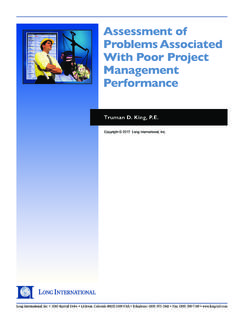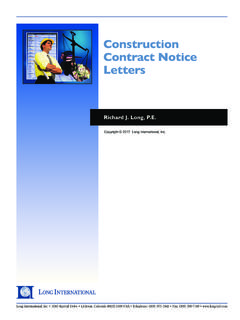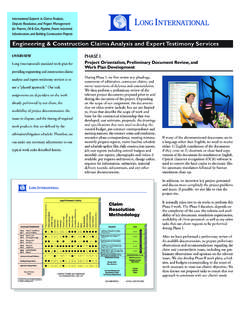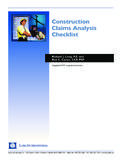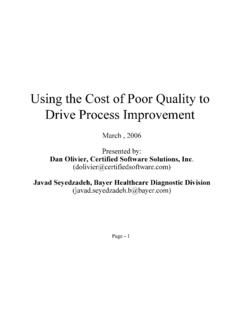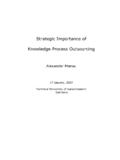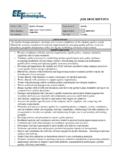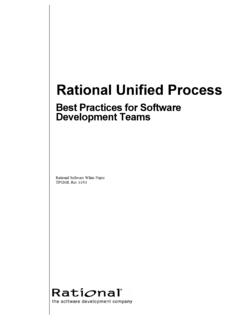Transcription of Philip R. Moncrief, P.E. - Long International
1 Philip R. Moncrief, Copyright 2004. 2016 Philip Long International , R. Moncrief Inc. L ONG International . Long International , Inc. 5265 Skytrail drive Littleton, Colorado 80123-1566 USA Telephone: (303) 972-2443 Fax: (303) 200-7180 Cost Control for the Project Manager Philip R. Moncrief, Table of Contents 1. INTRODUCTION .. 1 2. DEFINITIONS .. 2 3. ESTIMATING .. 2 ESTIMATE 3 4. EXECUTION PHASE .. 4 5. COST OVERRUNS .. 5 PROJECT DEFINITION .. 5 CONTRACTS .. 6 OWNER .. 6 SCHEDULE .. 7 COST OF HOME OFFICE AND ENGINEERING SERVICES .. 7 PROCUREMENT AND SUBCONTRACTING .. 8 CONSTRUCTION .. 8 JOINT VENTURE MANAGEMENT .. 9 OTHER IMPORTANT POINTS.
2 9 CUMULATIVE IMPACT OF CHANGE .. 9 List of Figures Figure 1 Opportunity to Influence Project Expenditures in Construction .. 1 Copyright 2004 Philip R. Moncrief i Cost Control for the Project Manager 1. INTRODUCTION. Good cost control is the hallmark of successful Project Managers. How do you do it? If it were easy, everyone would do it well. Well, it's not easy and the bigger the project, the harder it is to do well. Controlling costs is basically the same whether the project is cost reimbursable or lump sum. The difference is whose money is at risk the Owner's or the Contractor's. The first principle of cost is that every project has an ultimate cost.
3 It can be minimized by clever execution or by removing unneeded scope and features, but there is an ultimate cost. The trick is first to estimate that cost early and then manage to it. Everyone has seen this cost influence curve: Figure 1. Opportunity to Influence Project Expenditures in Construction This curve, which has been extensively documented, demonstrates that the cost of a project can most be influenced at the start, during scope definition. As the project proceeds, the ability to influence the final cost decreases so that by the time detailed engineering and procurement are underway, the ability to influence the cost is in rapid decline and by the time engineering is complete and construction is underway, the ability to influence the project cost is very low.
4 The second principle of cost is that small things can have large effects. It's relatively easy to keep track of the cost of the large elements major equipment for example. It is quite another to Copyright 2004 Philip R. Moncrief 1. Cost Control for the Project Manager keep track of small things electrical cable, pipe fittings, or conduit fittings for example. Designing, procuring and installing the little things (called bulk materials in the process plant industry) can cost up to 60% of the total project costs. A 10% overrun across the board in bulks could result in up to a 6% increase in overall project costs. Even the practice of over-buying to create an available surplus of, say 10%, can increase the overall cost by 2 3%.
5 The little things can really add up. 2. DEFINITIONS. Here are the basic definitions of cost control: Deviation any change from the current plan, whether or not it has cost, schedule, or quality implications. Deviations can be mitigated so that there is no impact on cost, schedule, or quality or they can become Trends or Change Orders. Trend a Deviation that has been identified to have cost, schedule, or quality implications. On Cost Reimbursable contracts, trends are increases in the cost or extensions to the schedule of the project and are formally transmitted to the Owner. On Lump Sum projects, trends that do not become change orders are an additional cost to the Contractor and decrease his profit on the project.
6 Scope Change a Deviation that includes a change in project scope from the contractual basis. Change Order a Trend or Scope Change that has cost, schedule, or quality implications and that changes the contractual basis for the project extending the schedule, increasing the base cost, or changing the delivered project. Change Orders are normally formally signed off by both the Contractor and the Owner. 3. ESTIMATING. It is beyond the scope of this article to describe the art of estimating in any detail. Nevertheless, a good estimate (not fat and not un-creditably low) is the key to successful project execution. Knowing how to get a good estimate can be the secret to a good project.
7 It is often said There aren't any good estimators anymore. They all retired/quit/got promoted.. That cannot be true. Projects today are more complex, have more participants and, in some cases, are larger. Good estimates keep getting produced. Companies have developed cost databases that can provide historical cost information from which to complete the estimate. The trick is knowing what is in the database and how to apply it. Here, a good estimator is worth his Copyright 2004 Philip R. Moncrief 2. Cost Control for the Project Manager weight in gold, but a good Project Manager working closely with estimating can accomplish the same result.
8 The Project Manager must deeply involve himself in the estimating process. That doesn't mean doing the estimate (except perhaps for a small project), it means being involved in every decision, checking the scope that is being estimated, and testing the estimate using rules of thumb. Above all else, the Project Manager must be the ultimate manager of the scope of an estimate. Deciding and documenting what is to be included in the estimate can save a lot of heartache and rework later. In creating the estimate scope, a lot of the uncertainties in the project will surface and can, hopefully, be resolved (or at least an allowance or contingency can be added).
9 It's easy to let the estimators work up the estimate with the engineers, procurement people, and construction staff, but by not involving himself in the day-to-day decision making, the Project Manager risks getting an estimate that does not really represent the project or (often) is high and no one knows why. Once the estimate has been prepared and has undergone the normal checking, the Project Manager (and often his management) needs to review the estimate thoroughly. The first level of review should be with the engineers and others who created the estimate input. Check that the correct scope was used, that no additional contingency was added during this phase, and that every good cost saving idea has been developed and included.
10 This is a good time to also check the man-hour estimates of engineering and other home office personnel. Some of the best reviews require each engineering and home office discipline to justify their man-hour estimates through discussing the scope that they will perform and comparing the project to historical norms for similar projects. These reviews typically are group sessions with all disciplines present to look for overlaps or gaps in scope between discipline groups or differences in approach. Spending half a day to several days on this detailed review is normally time well spent. By the end of the review, the Project Manager should have a firm grasp of the details of the estimate basis.



